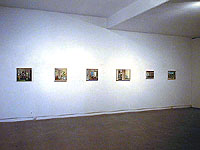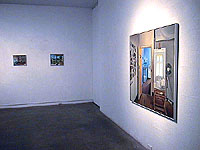

Richard
Gunning



Interior Paintings
5 - 26 October 2003
-
Richard
Gunning is one of the most collectable of the remarkable group of
figurative painters, who emerged in Perth during the 1980’s.
They were concerned with the facts of day-to-day life, in a rapidly
changing environment. They drew their imagery from a comfortable,
soft–centred bohemianism, still very much part of the Perth
scene, and the traditional atmospherics and mystique of the artist’s
studio, as popularised by Matisse and other great moderns. They
emphasised the pursuit of technique, almost as an end in itself,
when this was little valued.
By the time of Ballroom 1995, an image of his studio/residency
at the time Gunning had already consolidated these themes with a
unique technique that sustains a magical silken daylight throughout
canvas. This quietly intense presence evolved in Studio Visit 1999
and in a series of table-top and chair-top still lives such as Blue
Table 1998 a painterly subject with impeccable modernist associations
from Cezanne to Matisse.
Like his mentors Gunning reworks the same domestic motif over time.
The black and white, conte and charcoal Drawing for Blue Table
2000, from his current exhibition,. demonstrates his obsession
with crowded compositions, which present a complex challenge to
any artist obsessed with figuration. Moreover, as Cezanne found,
they raise fundamental questions for both artist and viewer about
the presence of each object, its role in daily life and memory.
Presence is the subject in Michele and Jurek's Place 2000
(oil on linen 45 x 40 cm), a view of the kitchen of some artist
friends a composition from Dutch seventeenth century genre painters.
The back door of the empty room swings open. A small dog is silhouetted
against the sunlight streaming through it. Gunning’s technique,
however, now leans towards the momentary visual anecdote commonly
found Bonnard. The blue jug on the table exists asi no more than
three strokes in two tones of blue and white, in the single intense
moment before its owners return.
Since his student days Gunning has maintained a taste for low profile
surrealism, a romantic magic reality that echoes Friedrich but also
de Chirico. He fills New Room 2003 (oil on linen 71 x 61
cm), with a unobstructed volume of clear light, invoked solely by
the shadows on its walls. Gunning’s robust but sensitive work
is eminently collectible.
-
Dr. David Bromfield
-
For
Australian Art Collector Summer 2003
|
1
Studio
Interior 2001
Oil
on Linen
119
x 130 cm
Acquired
Private Collection
2
Window
with Easel 2000
Oil
on Canvas
105
x 62 cm
Collection:
City of Wanneroo
3
New
Room 2003
Oil
on Linen
71
x 61 cm
Acquired
Central Metropolitan College of T.A.F.E.Collection
4
Studio
Corner with Flowers 2000
Oil
on Panel
66
x 61 cm
Acquired
Private Collection
5
Michele
and Jurek's Place 2003
Oil
on Linen
45
x 40 cm
Acquired
Private Collection
6
Study
for Studio Interior 2001
Oil
on Linen
40
x 43.5 cm
Acquired
Private Collection
7
Wheelock
Way Interior 2001
Oil
on Linen
40.5
x 40.5 cm
Acquired
Private Collection
8
Wheelock
Way Interior No2 2002
Oil on Linen
61 x 61 cm
Acquired
Central Metropolitan College of T.A.F.E. Collection
9
View
of Kitchen and Studio 2003
Oil
on Panel
42
x 59.5 cm
$
2,200
Acquired
Private Collection
Wheelock
Way View 2002
Oil
on Linen
40
x 35 cm.
11
Studio
Visit No 2 2000
Oil
on Canvas
38
x 30 cm
12
Drawing
for The Blue Table 2002
Charcoal
and Conte on paper
87.5
x 70 cm
Acquired
Private Collection
13
Studio
Window Study 1999
Oil
on Paper
48
x 28 cm
Acquired
Private Collection
- Richard
Gunning's paintings reveal an intense interest in the aesthetic possibilities
of the interior spaces of studio and home. Focus is upon the value
and integrity of ordinary objects within these settings-a shoe, ladder,
chair, fruit, flowers. In the works (whether scrutinising a few objects
or an entire room) concentration is upon variety of surface texture
and compositional balance, aided by the unifying (and often dramatic)
effects of colour and light.
- Beyond
an exposition of technical virtuosity, these paintings suggest a considerable
interest in the nature of illusion and construction of the visible
world in painting. The various images of Gunning's studio interior
can be read as a series which moves between concurrent desires to
reveal and conceal. The Studio Visit (1999) depicts a wide
view of the artist's workspace, detailed and partially reorganised
aspects of which are presented in other works. In the space of the
studio objects are exposed in varying states-doors are left open and
closed, a mirror reflects other aspects of the room, fabric swathes
table and chairs, and curtains are pushed back to glimpse a world
outside-so that what is not revealed in one work might be understood
in another. Renderings of existing studio paintings also appear as
objects within particular works. In White Chair with Painting (1999)
the microcosmic world of a still life with chair, jacket, sneakers,
take-away coffee cup and shell is combined with a studio interior
study propped upon the shoes, revealing aspects of the larger environment
in which the objects in the painting 'reside'.
- Gunning's
work continually oscillates between an austerity and economy in the
use of objects (Chair with Peach Painting, 1999) and almost
exaggerated combinations of the ephemera of everyday life (The
Blue Table, 1998). The abundance of items collected in the latter
image is almost a parody of the Dutch still life tradition in which
objects appear delicately balanced just prior (it seems) to their
inevitable disintegration. The potentially chaotic effects of such
an assortment is, however, entirely avoided as disparate elements
are unified through the use of strong colour and dramatic lighting.
Concentration upon the effects of light also transforms this amalgam
into a group of objects with significant aesthetic value, to be approached
with some reverie.
- Although
the artist does not present himself in these studio and domestic interiors,
his presence is consistently inferred in the precious objects revealed
and spaces inhabited daily. This adds a highly imaginative dimension
to the viewer's act of looking. Narratives within and without the
picture frame are suggested despite an almost absolute lack of human
presence in the works. When a figure is added (as in the Studio
Visit, 1999) the individual is shown as thoroughly absorbed with
pictures on a pin board. Her presence does not deflect from the real
action of the picture-rather it mirrors the position of the viewer,
whose gaze is similarly concentrated upon the intense variety of objects
depicted and the meanings they evoke.
- Sally
Quin Curator (Collections)Lawrence Wilson Art Gallery The University
of Western Australia
|
Back
to Top
